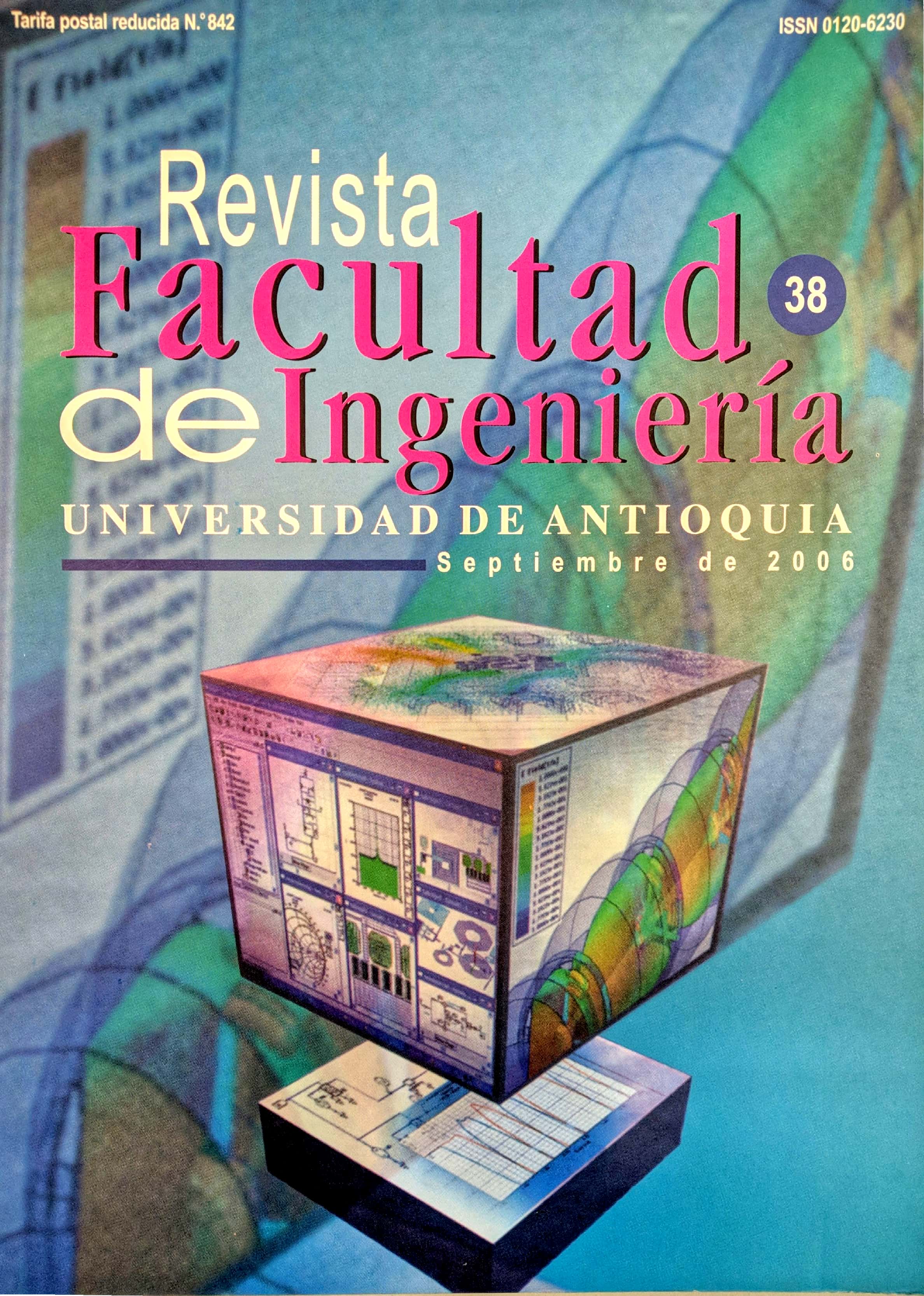Análisis exergético de un motor de automoción operando con gas natural: efecto de la configuración del kit de conversión y del sistema de encendido
DOI:
https://doi.org/10.17533/udea.redin.343230Palabras clave:
Análisis exergético, gas natural vehicular, motores bicombustibleResumen
Este trabajo se desarrolla a partir de un proyecto de investigación en el que se estudiaron los efectos de la configuración del kit de conversión y algunos parámetros del sistema de encendido sobre las prestaciones de un motor de automoción bicombustible funcionando con gas natural. Se ha realizado un análisis exergético del motor para las diferentes configuraciones del kit bajo cinco modos de operación y se encontró la configuración más conveniente según la eficiencia exergética y la destrucción de exergía. Se encontró que el tamaño del mezclador no tenía un efecto significativo sobre la eficiencia del motor, mientras que su ubicación y el tamaño del regulador son importantes. A la configuración seleccionada se le hizo un estudio de variación de algunos parámetros de encendido y se encontró que hay un efecto moderado en los términos del balance exergético, logrando mejorar la eficiencia exergética máxima alcanzada cerca de un 11%.
Descargas
Citas
J. Agudelo, R. Moreno, I. Bedoya. “Influencia de la configuración del kit de conversión en el desempeño mecánico-ambiental de un motor de encendido provocado (MEP) bicombustible gasolina-gas natural vehicular”. Revista Facultad de Ingeniería. Vol. 31. 2004. pp. 102-115.
C. Rakopoulos, E. Giakoumis. “Second-law analyses applied to internal combustion engines operation”. Progress in Energy and Combustion Science. Vol. 32. 2006. pp. 2-47. DOI: https://doi.org/10.1016/j.pecs.2005.10.001
R. Gaggioli, P. Petit. “Use the second law, first”. CHEMTECH. Vol. 7. 1977. pp. 496-506.
M. Rosen. “Second-law analysis: Approaches and implications”. International Journal of Energy Research. Vol. 23. 1999. pp. 415-429. DOI: https://doi.org/10.1002/(SICI)1099-114X(199904)23:5<415::AID-ER489>3.3.CO;2-Z
I. Dincer, Y. Cengel. “Energy, entropy and exergy concepts and their roles in thermal engineering”. Entropy. Vol. 3. 2001. pp. 116-149. DOI: https://doi.org/10.3390/e3030116
A. Bejan. “Fundamentals of exergy analysis, entropy generation minimization, and the generation of flow architecture”. International Journal of Energy Research. Vol. 26. 2002. pp. 545-565. DOI: https://doi.org/10.1002/er.804
M. Moran, E. Sciubba. “Exergy analysis: Principles and practice”. Journal for Engineering of Gas Turbines and Power. Vol. 116. 1994 pp. 285-290. DOI: https://doi.org/10.1115/1.2906818
W. Kaiser. “Rudolf diesel and the second law of thermodynamics”. En: German News Magazine. 1997. http://www.germanembassy-india.org/news/june97/76gn16.htm. Consultada en junio de 2004.
J. Caton. “A review of investigations using the second law of thermodynamics to study internal combustion engines”. SAE paper 2000-01-1081. Estados Unidos. 2000. DOI: https://doi.org/10.4271/2000-01-1081
D. Foster. “An overview of zero-dimensional thermodynamic models for IC engine data analysis”. SAE paper 852070. Estados Unidos. 1985. DOI: https://doi.org/10.4271/852070
H. Shapiro, J. Van Gerpen. “Two zone combustion models for second law analysis of internal combustion engines”. SAE paper 890823. Estados Unidos. 1989. DOI: https://doi.org/10.4271/890823
M. Anderson, D. Assanis, Z. Filipi. “First and second law analyses of a naturally-aspirated, Miller cycle, SI engine with late intake valve closure”. SAE paper 980889. Estados Unidos. 1998. DOI: https://doi.org/10.4271/980889
J. Caton. “Results from the second-law of thermodynamics for a spark-ignition engine using an engine cycle simulation”. En: Proceedings of the 1999 Fall Technical Conference, ASME-ICED Paper N.º 99-ICE-239. Michigan. 1999. pp. 35-49.
J. Caton. “A cycle simulation including the second law of thermodynamics for a spark-ignition engine: Implications of the use of multiple-zones for combustion”. SAE paper 2002-01-0007. Estados Unidos. 2002. DOI: https://doi.org/10.4271/2002-01-0007
F. Alasfour. “Butanol – A single-cylinder engine study: availability analysis”. Applied Thermal Engineering. Vol. 17. 1997. pp. 537-549. DOI: https://doi.org/10.1016/S1359-4311(96)00069-5
W. Gallo, L. Milanez. “Exergetic analysis of ethanol and gasoline fueled engines”. SAE paper 920809. Estados Unidos. 1992. DOI: https://doi.org/10.4271/920809
A. Valero, M. Lozano, G. Serra, G. Tsatsaronis, J. Pisa, C. Frangopoulos, M. von Spakovsky. “CGAM Problem: Definition and conventional solution”. Energy. Vol. 19. 1994. pp. 279-286. DOI: https://doi.org/10.1016/0360-5442(94)90112-0
V. Stepanov. “Chemical energies and exergies of fuels”. Energy. Vol. 20. 1995. pp. 235-242. DOI: https://doi.org/10.1016/0360-5442(94)00067-D
T. Kotas. The exergy method of thermal plant analysis. Florida. Krieger publishing Company. 1995. pp. 44-48, 268.
A. Amell, J. Agudelo, F. Cadavid. “El gas natural: ¿nuevo vector energético?”. Revista Facultad de Ingeniería. Vol. 25. 2002. pp. 36-48.
A. Bejan. Advanced engineering thermodynamics. 2.ª ed. Nueva York, John Wiley & Sons. 1989. p. 394.
J. Heywood. Internal combustion engine fundamentals. Nueva York. McGraw-Hill. 1988. pp. 678-680.
C. Ferguson y A. Kirkpatrick. Internal combustion engines. Applied thermosciences. Nueva York. John Wiley & Sons. 2001. pp. 117-118, 322.
M. Muñoz, F. Payri. Motores de combustión interna alternativos. Madrid. Sección de Publicaciones, Escuela técnica superior de Ingenieros Industriales, Universidad Politécnica de Madrid. 1989. pp. 69-71.
A. Bejan, G. Tsatsaronis, y M. Moran. Thermal design and optimization. Nueva York. John Wiley & Sons. 1996. pp. 519-522.
J. Caton. “On the destruction of availability (exergy) due to combustion processes – with specific application to internal-combustion engines”. Energy. Vol. 25. 2000. pp. 1097-1117. DOI: https://doi.org/10.1016/S0360-5442(00)00034-7
Descargas
Publicado
Cómo citar
Número
Sección
Licencia
Los artículos disponibles en la Revista Facultad de Ingeniería, Universidad de Antioquia están bajo la licencia Creative Commons Attribution BY-NC-SA 4.0.
Eres libre de:
Compartir — copiar y redistribuir el material en cualquier medio o formato
Adaptar : remezclar, transformar y construir sobre el material.
Bajo los siguientes términos:
Reconocimiento : debe otorgar el crédito correspondiente , proporcionar un enlace a la licencia e indicar si se realizaron cambios . Puede hacerlo de cualquier manera razonable, pero no de ninguna manera que sugiera que el licenciante lo respalda a usted o su uso.
No comercial : no puede utilizar el material con fines comerciales .
Compartir igual : si remezcla, transforma o construye a partir del material, debe distribuir sus contribuciones bajo la misma licencia que el original.
El material publicado por la revista puede ser distribuido, copiado y exhibido por terceros si se dan los respectivos créditos a la revista, sin ningún costo. No se puede obtener ningún beneficio comercial y las obras derivadas tienen que estar bajo los mismos términos de licencia que el trabajo original.










 Twitter
Twitter